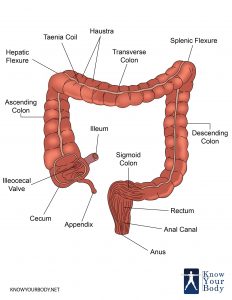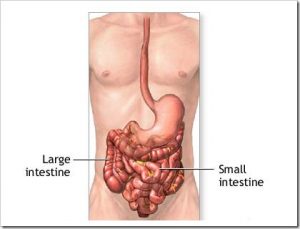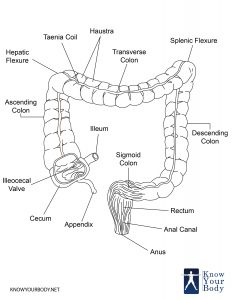The end part of the human digestive system is the large intestine. No digestion occurs in this organ but it certainly does play an important role in removing the undigested food particle.
Our alimentary canal does not digest whatever food we eat completely. The foods that remain undigested are passed through the large intestine and ultimately removed through the anus. As a result, the large intestine is an important functioning organ of the alimentary canal.
Large Intestine Definition
The large intestine is a long tubular structure that is not coiled like small intestine. This tubular structure is sometimes known as large bowel or colon. The large intestine is wider in diameter and hence allows the lucid movement of the undigested food particles through it.
This sole organ covers up one-fifth of the length of the entire alimentary canal.
Parts of the Large Intestine
The large intestine is divided into four parts that form the entire length of the intestine.
- Cecum
- Colon
- Rectum
- Anus
The colon, however, has three parts depending upon the concerned position. They are:
- The ascending colon that moves in an upward direction
- The transverse colon that runs almost horizontally with the ground
- The descending colon that descends down the body and leads to the rectum
- The S-shaped sigmoid colon
Large Intestine Location
The large intestine as a single unit covers the abdominal cavity. It starts from where the ileum ends, ascends upwards and passes across the top of the stomach transversely. Then it again descends down along the left side of the body and forms the S-shaped structure. This S-shaped structure gives rise to the rectum and finally the anal opening.
Large Intestine Structure and Anatomy
- The large intestine starts from the ileocecal sphincter present at the end of the ileum.
- It then forms an inclined T which runs both superiorly and inferiorly.
- The superior part gives rise to the ascending colon while the inferior branch meets a dead-end. This small pouch-like structure is known as the vermiform appendix and is vestigial in nature.
- The vermiform appendix is attached with the ascending colon via the Gerlach’s valve.
- The ascending colon rises upwards along the extreme right side of the abdominal cavity till it reaches just below the diaphragm.
- At that point which is the hepatic flexus, the ascending colon takes a sharp right angular turn and starts to run transversely across the stomach.
- The transverse colon is suspended from the stomach through the greater omentum, a peritoneal fold.
- On the back side, the colon is attached to the abdominal walls via transverse mesocolon.
- When it reaches the splenic flexus at the extreme left corner of the abdominal cavity, it turns around by ninety degrees and descends downwards.
- After descending down, the descending colon reaches the sigmoid flexus. At this point, the colon bends medially into an S-shaped structure called the sigmoid colon.
- It then enlarges into a bulb-like structure called the rectum which is the ending part of the alimentary canal.
- The tubular rectum finally terminates into an opening known as an anus.
Large Intestine Wall Histology
The large intestinal wall is made up of four layers.
- Mucosa is the innermost layer of the large intestine surrounding the lumen
- Unlike small intestine, the mucosa here is free of villi and has a soft surface
- It is made up of single-layered columnar epithelial cells.
- The columnar epithelium has secretory cells that secrete mucus into the lumen of the intestine. The mucus ensures the lucid movement of the bowel.
- Next to the mucosa lies the layer of blood vessels nerve fibers and connective tissue. This vascular layer is known as the submucosa. This layer acts as the anchor for the other layers of the large intestine.
- The next layer in the outward direction is the visceral muscle layer known as muscular. This layer consists of radial and circular muscles that bring about the contraction and relaxation of the intestinal wall.
- The external-most layer is made of a single layer of squamous epithelial tissue known as the serous layer. It secreted the serous fluid into the surface. The fluid acts as a lubricating medium and prevents the friction with other organs.
Function of Large Intestine
The function of the large intestine is not only limited to the formation of feces. Rather it covers a huge arena of functionality.
- The large intestine helps in the formation of stool. The undigested food particles are passed through the entire four sections of the colon. The colon walls absorb the water and other fluids from the undigested food and facilitate the solidification of the liquid. As a result, feces are formed. The absorbed water is important for controlling metabolism in our body.
The undigested food should not stay for too little time or too long time within the colon. The former will cause less or minimal absorption of water and hence will lead to diarrhea. The later will cause excess water absorption and hence constipation.
- The large intestine is the hub of many useful bacteria that help in the breakdown of the undigested food particles. During this breakdown, they release Vitamin K, vitamin B6, riboflavin and many other. Vitamin K is greatly absorbed into the bloodstream as the vitamin is an important clotting factor. Along with vitamins, many minerals and ions are too absorbed along with the water into the bloodstream. This maintains the ionic balance of the blood.
- The anaerobic fermentation of the undigested carbohydrates and fatty acids produces lactic acid and other acids. These acids are strong enough to corrode the mucosa membrane due to the highly acidic medium in the colon. In order to neutralize the acidic medium, large intestine secretes alkaline juices into the lumen, thereby maintaining the pH.
- Large intestine helps in maintaining body’s immune system greatly. It reduces antibodies that help in fighting the colon diseases. Also, the mucosa layer of the intestine prevents the absorption of the harmful bacteria into the bloodstream.
Large Intestine Innervations
Like the small intestine and the rest of the gut, the sympathetic and parasympathetic nervous system triggers the neurogenic working of the large intestine.
- Vagus nerve from the tenth spinal nerve imparts parasympathetic impulses to the large intestine.
- The pelvic splanchnic nerves do another parasympathetic innervation of the large intestine.
- The thoracolumbar nerves from the tenth thoracic vertebrae to the second lumbar vertebrae (T10-L2) are responsible for the sympathetic inhibitory actions of the large intestine.
- These nerves form three synapses namely- superior mesenteric plexus, inferior mesenteric plexus and inferior hypogastric plexus.
- Cecum, appendix, ascending and transverse colon receives the sympathetic stimulations from the superior mesenteric plexus
- The inferior mesenteric plexus stimulates the colon from the point of left colic flexure and then to the rectum.
- The inferior hypogastric plexus also innervate rectum.
Large Intestine Pictures
Large Intestine Clinical Significance
The colon diseases mainly affect large intestine. Other than that, there are certain specific disorders that affect a certain area of the entire column of the large intestine.
- Appendicitis
- Chronic functional abdominal pain
- Colitis
- Colorectal cancer
- Colorectal polyp
- Constipation
- Crohn’s disease
- Diarrhea
- Diverticulitis
- Diverticulosis
- Ileus
- Intussusceptions
- Irritable bowel syndrome
- Ulcerative colitis
FAQs
How Long is the Large Intestine?
The long intestine is about 1.5 meters (5 feet) long in length.
What are hemorrhoids?
Haemorrhoids is a disease of the anus where the blood vessels lining the opening swell up and starts bleeding. The bleeding appears in the stood of the person.
What is a colon polyp?
Polyps are small clusters of cells that grow on the inner wall of the colon. Under most of the circumstances, the colon polyps are benign but some of them might turn cancerous.
What causes colon cancer?
The reasons for the colon cancer are not properly known. However, scientists have jotted down certain reasons like the aging of an individual, appearance of colon polyps, ulcerative colitis, etc.
How common is colon cancer?
Colon cancer is quite common in both the genders as people are likely to develop the cancerous cells in their colon.




No comments yet.